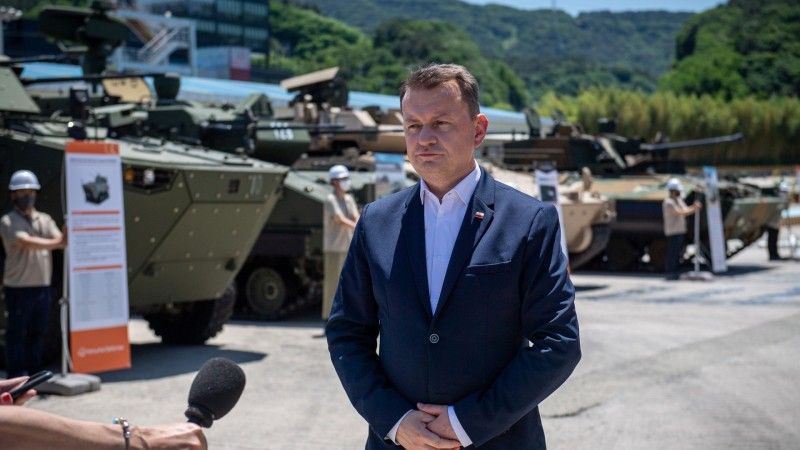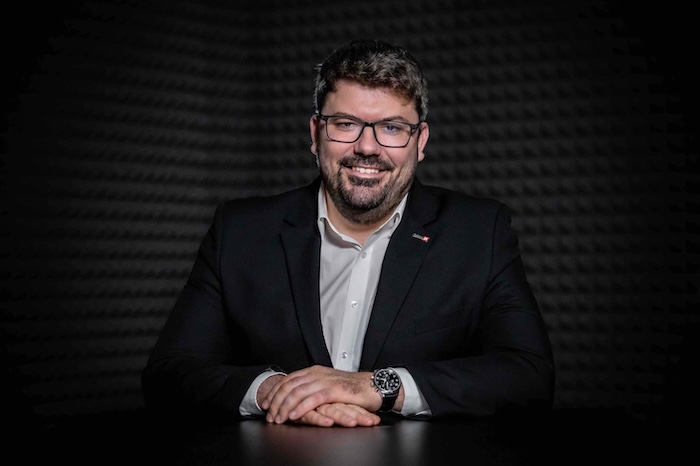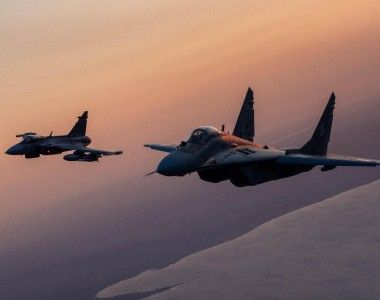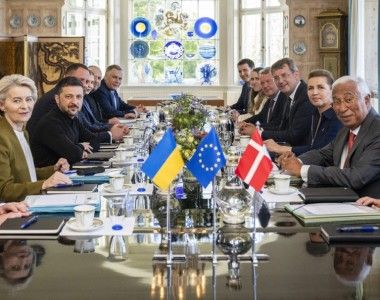Poland to Buy 1,000 MBTs. Minister Błaszczak Also Outlines a Plan To Procure Extra F-35s or F-15s [INTERVIEW]

Currently, no option to procure new F-16s exists, due to the manufacturer’s policy - as Lockheed now focuses on the F-35. I have talked about this multiple times, with our US partners. We cannot wait, while the FA-50 deliveries would happen next year, stresses the head of the Polish Ministry of Defence, Mariusz Błaszczak. The Minister has also outlined the upcoming stages in the acquisition of the Korean K2 MBTs and K9 howitzers, along with a transfer of technology.
Jędrzej Graf: The decision on procurement of the Korean K2 MBTs, K9 sphs, and FA-50 aircraft has been unprecedented. The Polish Armed Forces operate, or procure in parallel modern equipment as such, manufactured in Poland, Italy, or the US. Why is it that the Polish Ministry of Defence does not procure more equipment that is already implemented - such as the F-16, or the M-346? The cost associated with commissioning, logistics, and servicing, tied to brand new, previously unused armament in multiple variants translate into extra several billion zlotys in Life Cycle Cost. And, at the same time, we are acquiring Patriot systems, HIMARS, the F-35, and many other solutions.
Mariusz Błaszczak, head of the Polish MoD: The criminal assault carried out by the Russian Federation, targeting Ukraine, and the unpredictable nature of Putin means that we need to accelerate the equipment modernization even further. It is of key importance to increase the levels of security as fast as possible for Poland. We can do this only by creating a strong military. Strong enough to deter any potential aggressor from deciding to attack.
Deciding to purchase equipment in South Korea, I had to consider a couple of aspects, including lethality of weapons, delivery tempo, or industrial benefits. The agreement with the Koreans that we have managed to negotiate fuses all of the above elements. Other equipment manufacturers have not been able to deliver armament of that quality at so short notice, and with so broad collaboration with the Polish defence industry.
Remember, our defence industry has been weakened for decades. We have lost numerous, precious competencies that we need to restore now, but this is a long-term process, and we cannot afford to wait any longer. We remember the needs of the industry, but in the back of our heads, we know how serious the threat in the east is. And the necessity to gradually improve Poland's and Polish citizens' security is of absolutely paramount importance. And this security will only be granted to us by a well-equipped army. Not in 10, or 20 years, but now.
The Russian aggression against Ukraine has accelerated the procurement decisions, but as examples of agreements concluded by the Polish Ministry of Defence in the last 2 decades, involving foreign contractors, the interest of the Polish defence industry has not always been secured. The domestic businesses were to engage in a conversation with the western partners, according to B2B formula, after the main, governmental agreement was signed. But the results were usually poor. Today, under a lot of pressure, talks with the Koreans are being finalized. Will manufacturing, maintenance, right to upgrades, or export for the Polish defence companies be granted, within the agreements signed by the Polish Ministry of Defence, concerning entities engaged in K2PL, K9PL, and FA-50PL programmes?
All three agreements assume that a very broad industrial cooperation is established, with a maximum delivery tempo. The K2 MBT contract has been divided into two stages. During the first stage, we would procure 180 main battle tanks, the deliveries are to begin this year. In the second stage, 800 K2PL main battle tanks would be acquired, and manufactured in Poland, by the Polish defence industry, thanks to a transfer of technology that we have negotiated. Ultimately, the MBTs procured during the first stage would also be Polonized and brought to the K2PL standard.
Along with the MBTs, support assets would also be procured in Korea - ARVs, engineering support vehicles, and bridges. The remaining elements would be based on the Polish solutions. When it comes to the K9 howitzers, a staged approach has been adopted here as well. The first step would be to procure 48 howitzers, some of which would be received by us this year, to fill in the gap that appeared once we have handed off equipment to Ukraine. Next, we would procure more than 600 howitzers that would be manufactured in Poland, as K9PL. Notably, from the very start, the K9 would be equipped with Polish communications systems, and they would be plugged into the Polish integrated Topaz CMS. The transfer of technology tied to FA-50 would make it possible for us to establish a maintenance and servicing facility in Poland. The contracts were negotiated in collaboration with the PGZ Group so that the Polish industry can use this opportunity as much as possible.

Photo. cpl. Wojciech Król/CO MON
Why it was decided to procure the Korean K9 design? Alongside that variant, a declaration was made to procure another variant, K9PL. What the polonization of the K9 would involve, as the Polish industry already manufactures a similar, or even more advanced system - the Krab? The Ukrainian Armed Forces rate the Krab developed in Poland as the best among the 155 mm systems in use.
The Krab gun-howitzer is a perfect product, the capabilities of which can be seen when observing the war in Ukraine. We are utilizing manufacturing capacity regarding this equipment to the absolute max. Back in 2016, HSW S.A. was awarded a contract to deliver 96 Krab systems. We would need to wait a bit longer for further deliveries, as the contract signed with Ukraine is a priority undertaking - as Ukraine procured sphs at HSW as well. This year we would sign an agreement on the procurement of another 48 Krab systems for the Polish Armed Forces. HSW declares it would be able to deliver all of those in late 2026.
We want this to happen quickly so that we can order more Krab systems and replace the legacy Gvozdika systems. Our requirements are simply greater. I would like HSW to be able to ramp up its manufacturing tempo, I was asking the Polish industry for this, and I count they would speed up the tempo at which these weapons could be manufactured. I am well aware that this would not be simple, as the HSW facility is preparing Borsuk, among other projects - that we are waiting for, and as soon as it is available we would conclude a contract involving the maximum quantity that can be manufactured by the industry.

Photo. General Staff of the Armed Forces of Ukraine
And HSW is also manufacturing the Rak mortars, the ZSSW turrets, or the Baobab-K scattered minelaying system. Recently we have also signed a contract regarding the delivery of the Ottokar-Brzoza tank destroyers. If anyone accuses me of not using the capacity that the Polish industry offers, then that statement is not accurate. Always, the equipment manufactured in Poland is the first choice. Thus, the Agreement assumes that the K9PL howitzers would be manufactured in Poland, in their entirety, they would be using the Polish components, and they would be plugged into Polish communications systems. This is a huge opportunity for the Polish defence industry. I would like to state it clearly - we are not resigning from the Krab system. It would still be the backbone howitzer operated by the Polish military. We also want the Korean howitzers, and the Krab, to be used by HSW to develop a future howitzer, making use of what is best in both solutions.
As a result of the above, the Polish Army would operate three 155 mm self-propelled howitzer types, using a tracked platform, which also is unprecedented globally. What would the delivery schedule be, for K9 and K9PL? Can you list any numbers?
The delivery of the first 48 K9 examples would happen this, and next year. Delivery of another 600 howitzers would begin in 2024, and as of 2026, the manufacturing process would be taking place in Poland. Also, the howitzers that would be delivered to Poland first would be brought to the K9PL standard after 2026. We are speaking of two, not three howitzer types. We are watching the war in Ukraine closely, seeing how key the role of artillery remains. For K9, the automatic loading is relevant, making it possible to quickly engage and leave the firing position. This is very important, as the Ukrainian experience has shown that the howitzers need to be acting quickly.

Photo. Hanwha Defence
What arguments support the selection of the FA-50 light fighter aircraft? This aircraft has been rejected by the Polish Ministry of Defence a decade ago, in the AJT system tender.
I was basing my decision on recommendations made by the Polish military pilots. The South-Korean FA-50s are light, multi-role aircraft based on the F-16, while the infrastructure that we have is ready to fluidly adopt them. They are fully interoperational with the equipment that we use, and it is a platform that has a major modernization potential, and a potential to integrate more modern weapons systems. These aircraft can be used in combat, but they also are a perfect training platform.
A pilot who has been trained on FA-50 only needs a few hours to start flying the F-16 on his own. The cost of training as such is much lower, and thus we would be able to train more pilots. The M-346s used now have too low availability - I was reporting on that matter several times, to my Italian counterpart. This is why we decided to procure the FA-50. We shall remember that the FA-50 themselves, based on the data coming from the current users, offer high availability of ca. 85%.
[#READ[ articles: 1006052 | showThumbnails: true ]
Was procurement of extra F-16s, instead of FA-50, being considered? Why the latter option has been chosen? The quicker deliveries are one thing, but the training of the pilots and implementation of new aircraft would take time. The last report issued by the Supreme Chamber of Control has exposed deep problems in pilots' training.
Currently, no option to procure new F-16s exists, due to the manufacturer’s policy - as Lockheed now focuses on the F-35. I have talked about this multiple times, with our US partners. We cannot wait, while the FA-50 deliveries would happen next year. Let’s have a look at Slovakia, where the delivery of the F-16s is so delayed, that we need the Polish fighters to patrol the Slovak airspace, within the framework of allied cooperation. Rapid replacement of post-Soviet fighters that we are still operating is very important for two reasons.
Above all, we are speaking of increasing our defence capabilities - MiG-29 and Su-22 are obsolete already. Secondly, it's also about the safety of the Polish pilots. Let us recall the fatal MiG-29 accident near Pasłęk. This situation cannot happen again. The problem also stems from the availability of spares for post-Soviet aircraft. We would need to procure these in Russia, and this, for reasons that remain obvious, needs to be ruled out. The attempts made at autonomous manufacturing of counterparts resulted in a tragedy, the death of the pilot, and employees working at WZL 2 in Bydgoszcz being accused of error.
Commissioning of FA-50 and pilots training would neither be time-consuming nor costly. As I have said already, our infrastructure is ready to accommodate them, while the aircraft themselves are similar to the F-16s.

Photo. ROKAF/KAI via Wikimedia Commons
How the FA-50 light fighters would be configured? AMRAAM medium-range missiles would be available for the Block 20 variant - that is currently under development. Are we going to procure such aircraft? How many of them we would acquire? And what the delivery schedule is going to look like?
Poland would buy 48 aircraft in total. The first 12 aircraft would be received in mid-2023. The aircraft would be configured in line with precise requirements defined by the Polish Air Force (IFF NATO). The aircraft would offer enhanced operational capabilities and they would come in the Block 20 standard.
What is the industrial cooperation in the FA-50 programme going to look like? Is there any talk about an FA-50PL variant? Poland does not have any manufacturing facilities in the area of military aviation today, these are mainly dealing with overhauls. Would the Polish businesses become a part of the FA-50 supply chain, manufacturing spares?
We are coming back to what I was saying - we need to gradually restore the lost defence industry potential, and also remember the necessity to enhance our combat capabilities. The contract with the Koreans assumes that the FA-50 maintenance facility would be established in Poland by 2026. Thanks to that procurement, we gain a new direction for spares, which is especially important for high-intensity conflicts, when one of the supply chains could be disrupted. This would make it possible to maintain the operational availability of combat aircraft in Poland at a top level.
I will add that the acquisition of those aircraft is not our last move, in the expansion of the capabilities of the Polish Air Force. We have accelerated the delivery of the F-35s. In the long run, we are planning to procure extra F-35s or F-15s, and we are watching closely the progress made by our South Korean partners when working on the KF-21 Boramae.
Now, onto the MBTs. We know that K2 MBTs would be procured, in two stages. What the configuration of the K2 MBT would be, in the first lot, and what the delivery schedule is going to be? What are the details of the K2PL programme? The proposals made by the Korean manufacturer in the area of transfer of technologies presented in recent years included the transfer of the manufacturing process to Poland and a joint Polish-Korean effort on the development of new combat platforms. Has any agreement been reached, in those areas? Which of the PGZ facilities would engage in the K2PL programme?
This year, the first out of 180 K2 MBTs, procured in stage one, would be received. Both K2, as well as K2PL, would feature Polish communications systems, and BMS that would be compatible with that implemented in the Abrams MBT.
Manufacturing of the K2PL in Poland would be launched in 2026. This year we would also unify the previously procured K2s so that they match the K2PL standard. The changes in configuration expected for the K2PL would include reinforced armour, the capacity to use US-made programmable rounds, retrofitting a 360 Degrees Observation System, and an active protection system, or a Polish .50-cal. machine gun. The Polish industry cannot currently manufacture main battle tanks.
Apart from reinforcing the Polish Armed Forces' combat capabilities, the contract with Koreans would also result in the restoration of armour manufacturing capacity. In the longer run, working with the Korean party, we are also planning to launch work aimed at the development of a new generation main battle tank.

Photo. Torbjørn Kjosvold / Forsvaret
Another question refers to issues that we discuss in the case of all agreements. Further initiatives aimed at procurement of new equipment types are a grand challenge in the training of specialized personnel - in aviation, artillery, and armour. Today that problem is persistent for the commanders of military units, who face staffing issues. You have launched large-scale recruitment programmes in the military. However, what are the plans made to stop the experienced officers from leaving the Armed Forces? Year by year, this matter is getting deepened, and it often concerns the best specialists, responsible for the advanced military equipment.
The Act on Homeland Defence is the response, along with its solutions. Apart from the increased military spending levels introduced by this legal act, we have provided solutions that are to attract new personnel and keep the most experienced soldiers in service. We have voluntary, basic military service in place, being an introduction for professional soldiers. Only in 3 months, we have received 9 thousand applications. We have very beneficial conditions for those engaged in military academic programs. The future officers, during their studies, would receive a salary equivalent to that received by the professional soldiers. Finally, we also have incentive pay for the soldiers willing to serve longer.
All of that forms a comprehensive system that would make it possible for us to increase the number of troops in the Polish Armed Forces to at least 300 thousand soldiers. Ultimately, we want that number to be even higher. I can assure you, that we will have plenty of personnel available to manage and maintain the latest equipment that we are currently procuring.
Thank you for this conversation.



